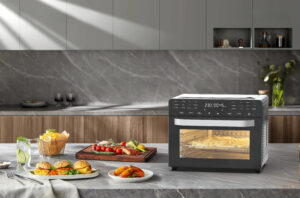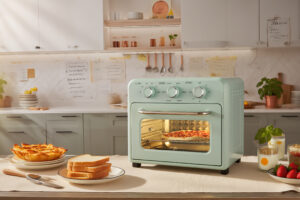As the Sales Manager at Foshan Linden Intelligent Appliances Co., Ltd., I’m passionate about helping home cooks preserve their favorite fruits with ease and efficiency. From our factory in China, we produce high-quality food dehydrators, alongside our 12L, 16L, and 30L air fryer ovens and air fryers, exported to North America, Europe, Russia, and the Middle East. A question I often hear at trade shows and through our website, lindensmart.com, is: Should I choose a horizontal or vertical food dehydrator for home use? I’m excited to share my expertise and guide you through this decision to find the perfect appliance for your kitchen.
In this article, I’ll compare horizontal and vertical food dehydrators, focusing on their features, performance, and suitability for preserving fruits at home. Drawing from our experience at Linden, where we design innovative appliances with customizable settings, I’ll break down the pros and cons to help you make an informed choice. Let’s dive into the world of food dehydration and find the best fit for you!
What Are Food Dehydrators?
Food dehydrators are countertop appliances that remove moisture from fruits, vegetables, herbs, and more, extending their shelf life. They use a heating element and fan to circulate warm air, preserving flavor and nutrients. According to WebMD, dehydrated fruits retain most vitamins and minerals, making them ideal for healthy snacking. The main types are horizontal and vertical dehydrators, each with distinct designs and benefits.
Horizontal Food Dehydrators
Horizontal food dehydrators have a fan and heating element at the back, blowing air across trays horizontally. Our Linden food dehydrators use this design, ensuring even drying for fruits like apples, mangoes, or berries.
Vertical Food Dehydrators
Vertical dehydrators have a fan and heating element at the top or bottom, blowing air vertically through stacked trays. They’re often more compact but may require tray rotation for consistent results.
Why Compare Horizontal vs Vertical?
Choosing between horizontal and vertical food dehydrators depends on your kitchen space, drying needs, and budget. I’ve seen buyers weigh these options carefully, and understanding the differences ensures you pick the right appliance for preserving fruits.
Key Differences: Horizontal vs Vertical Food Dehydrators
Let’s explore the main differences between horizontal and vertical food dehydrators, focusing on their impact on fruit preservation.
Airflow and Drying Consistency
Horizontal Dehydrators: Even Air Distribution
Our horizontal food dehydrators deliver consistent airflow across all trays. The fan at the back ensures uniform heat, drying fruits evenly without needing to rotate trays. Consumer Reports highlights horizontal airflow as a key factor for consistent results, making it ideal for large batches of fruit.
Vertical Dehydrators: Variable Airflow
Vertical dehydrators blow air from the top or bottom, which can lead to uneven drying. Trays closer to the fan dry faster, often requiring rotation. This can be a hassle for busy home cooks drying delicate fruits like strawberries.
Capacity and Tray Design
Horizontal Dehydrators: Spacious and Flexible
Our food dehydrators feature spacious, rectangular trays, perfect for large batches of fruit. The horizontal design allows for taller items, like fruit leather or thick apple slices, without height restrictions. This makes them great for preserving garden harvests or bulk produce.
Vertical Dehydrators: Compact but Limited
Vertical dehydrators use stackable, round trays, which are more compact but offer less space. They’re suited for small households but may struggle with large quantities or oversized items, limiting their versatility for fruit preservation.
Temperature Control and Precision
Horizontal Dehydrators: Precise and Versatile
Our horizontal food dehydrators offer adjustable temperature settings, typically 90–165°F. This precision ensures optimal drying for various fruits, from delicate berries at low temperatures to heartier bananas at higher ones. Healthline recommends specific temperatures for nutrient retention, which our models handle effortlessly.
Vertical Dehydrators: Basic Control Options
Vertical models often have limited temperature ranges or preset settings. While sufficient for fruits (130–140°F), they may lack the precision needed for other foods like herbs or meats, reducing their flexibility for home cooks who want versatility.
Ease of Use
Horizontal Dehydrators: User-Friendly Features
Our food dehydrators are designed for ease. They feature digital interfaces with preset modes for fruits, eliminating guesswork. Timers and adjustable thermostats make drying simple, even for beginners. The slide-out trays are easy to load and check without disrupting the process.
Vertical Dehydrators: Simple but Manual
Vertical dehydrators are straightforward, often with basic dials or switches. However, tray rotation can be time-consuming, and stacking trays requires careful arrangement to ensure airflow. This can be less convenient for frequent use.
Cleanup and Maintenance
Horizontal Dehydrators: Easy to Clean
Our horizontal dehydrators have removable, dishwasher-safe trays made of durable, food-safe materials. Fruit residue wipes off easily with a damp cloth, and the open design simplifies cleaning. This saves time after drying sticky fruits like mangoes.
Vertical Dehydrators: Slightly Trickier
Vertical models have stackable trays that may trap residue in crevices. While many are dishwasher-safe, cleaning the base (where the fan sits) can be harder, especially if juices drip during drying. This can make maintenance more labor-intensive.
Energy Efficiency
Horizontal Dehydrators: Efficient for Large Batches
Our horizontal food dehydrators use 0.6–1 kWh per use, depending on the model, per Energy Star. Their even airflow reduces drying time, saving energy when preserving large quantities of fruit.
Vertical Dehydrators: Lower Power for Small Loads
Vertical models typically use 0.4–0.6 kWh due to their smaller size. However, uneven drying may require longer run times or multiple sessions, potentially offsetting energy savings for larger batches.
Size and Kitchen Fit
Horizontal Dehydrators: Larger Footprint
Horizontal dehydrators, like ours, require more counter space due to their wider design. They’re ideal for kitchens with ample room or for users who prioritize capacity and performance over compactness.
Vertical Dehydrators: Space-Saving Design
Vertical dehydrators are more compact, with a smaller footprint due to their stackable trays. They’re perfect for small apartments or kitchens where space is limited, but their capacity is often lower.
Cost and Value
Horizontal Dehydrators: Premium Investment
Our horizontal food dehydrators are priced in the mid-to-premium range ($100–$300 for wholesale buyers). Their durability, versatility, and consistent performance make them a worthwhile investment for frequent users or those drying diverse foods.
Vertical Dehydrators: Budget-Friendly
Vertical models are generally more affordable ($50–$150). They’re a great entry point for beginners or those focused solely on fruit drying, but their limitations in capacity and versatility may not suit everyone.
Practical Applications for Fruit Preservation
Both types of dehydrators excel at preserving fruits, but their applications vary based on design and user needs.
Horizontal Dehydrators: Ideal for Bulk and Variety
Our horizontal food dehydrators are perfect for large-scale fruit preservation. Dry multiple trays of apples, peaches, or berries at once with consistent results. They’re great for creating fruit snacks, trail mixes, or ingredients for baking, with no need for tray rotation.
Vertical Dehydrators: Best for Small Batches
Vertical dehydrators suit small households or occasional fruit drying. They’re ideal for drying a few trays of strawberries or bananas for personal snacks. However, larger batches may require multiple sessions or frequent tray adjustments.
Health Benefits of Dehydrated Fruits
I’m passionate about healthy eating, and both dehydrators produce nutritious, preservative-free fruit snacks. Dehydrating retains most vitamins and minerals, per WebMD. Dried fruits are perfect for snacking, baking, or adding to cereals, with no added sugars or chemicals.
Reducing Food Waste
Both horizontal and vertical dehydrators help save overripe fruits. By drying produce before it spoils, you extend its shelf life and reduce waste, saving money and benefiting the environment.
Which Food Dehydrator Is Right for You?
Choosing between horizontal and vertical food dehydrators depends on your needs. Here’s how to decide, based on my experience with buyers.
Choose a Horizontal Food Dehydrator If You:
- Dry large batches of fruit or other foods like vegetables or meats.
- Want consistent drying without tray rotation.
- Need precise temperature control for various fruits.
- Have ample kitchen space for a larger appliance.
- Value versatility and advanced features like digital controls.
Our Linden horizontal food dehydrators are ideal for these needs, offering professional-grade performance and ease of use.
Choose a Vertical Food Dehydrator If You:
- Focus solely on drying small batches of fruit.
- Have limited kitchen space or a tight budget.
- Prefer a simple, beginner-friendly appliance.
- Don’t mind rotating trays for even drying.
- Need a compact, portable option.
Can You Use Both Types?
I often tell buyers they can benefit from both. Use a vertical dehydrator for quick, small-scale fruit drying and a horizontal model for larger or more diverse preservation tasks. Our Linden models complement any kitchen setup, offering flexibility for all your needs.
Quality and Certifications
At Linden, quality is our priority. Our horizontal food dehydrators undergo rigorous testing and meet UL and CE standards, ensuring safety and reliability. Their durable, food-safe materials guarantee long-term performance, making them a trusted choice for fruit preservation.
Logistics and Customer Support
From my experience with global buyers, logistics are crucial. Our food dehydrators are lightweight and easy to ship, ensuring timely delivery worldwide. We optimize production to meet tight schedules. Need assistance? I’m here at sales4@fslinden.com to provide expert guidance.
SEO-Friendly Tips for Choosing a Food Dehydrator
To pick the best food dehydrator, here are tips optimized for search terms like “horizontal vs vertical food dehydrators” or “best fruit dehydrators for home use”:
- Assess Your Needs: Decide if you need versatility or just fruit drying.
- Check Capacity: Choose based on batch size and kitchen space.
- Prioritize Consistency: Opt for horizontal models for even drying.
- Read Reviews: Explore platforms like CNET for user feedback.
- Test at Trade Shows: Try appliances hands-on to ensure they meet your needs.
Final Thoughts: Horizontal or Vertical Food Dehydrator?
As someone who loves helping home cooks preserve fruits, I believe our horizontal food dehydrators are the best choice for most users. Their even airflow, large capacity, and versatility make them ideal for consistent, high-quality fruit preservation. Vertical dehydrators are great for small spaces or beginners, but their limitations in drying consistency and capacity may not suit everyone. Your choice depends on your kitchen size, drying goals, and budget.
Ready to start preserving your fruits? Visit lindensmart.com to explore our food dehydrators, or email me at sales4@fslinden.com for personalized advice. Let’s make your fruit preservation easy and delicious!
Meta Title: Horizontal vs Vertical Food Dehydrators: Best for Home Fruit Drying
Meta Description: Compare horizontal and vertical food dehydrators for home use. Learn about features, performance, and capacity to choose the best for fruit preservation.




